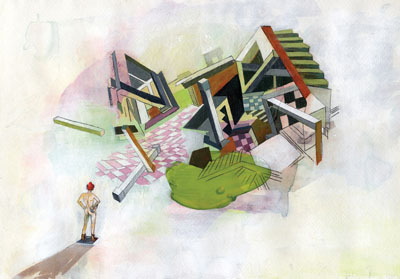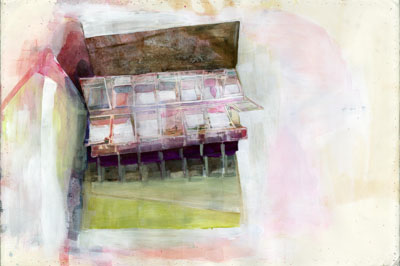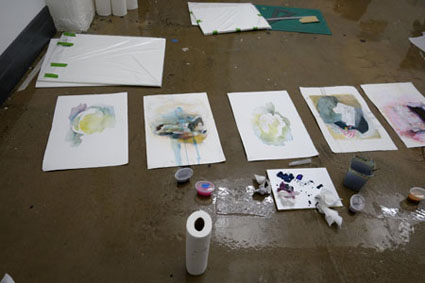Artist in Exile / Art as a Home
Mira Dayal
November 2015
I’ve been having more conversations recently about “currents” in contemporary art practice–conversations that inevitably culminate in ruminations upon the requisite energy, accumulated travel miles, and resulting exhaustion from keeping up with the current. This current traverses continents, navigates close relationships, and carves into conflict-ridden landscapes. It is insistent and dynamic, but above all, it is not flowing in a vacuum. Occasionally an artist becomes entrapped in a maelstrom within the current and must struggle to re-emerge. Art in this case becomes a space in which to first lose and then transform the subject. The maelstrom may have formed due to a natural disaster, internal or external. The artist is first concerned and then consumed, but she works through the disaster by searching for a new frame for her subjectivity.
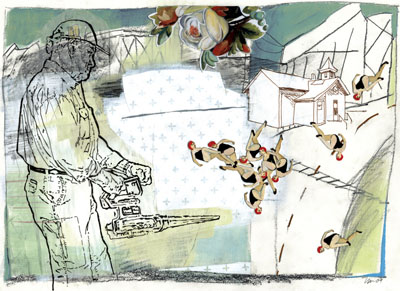 Blow (2009)
Blow (2009)
Nancy Morrow’s Blow (2009) reads as a patterned, abstracted “collision of sources,” as the artist put it, forming a flattened environment in which cartoon figures dominate an imagined narrative. While her works of the same year feel like someone else’s memories, they are accessible in that they follow the logic of illustration. In this composition, a man using machinery causes turmoil in the home; in another, a lawnmower seems to violently tear apart the corporeality of a woman. Pattern permeates each space, from dark corners of the home to thought bubbles.
Edifice (2013)
By the time she started pieces like Edifice (2013) however, Morrow had moved past collage-heavy compositions towards landscapes in which de Chirico shadows imply psychological retreat–even paranoia. Dark corners of the home no longer dominate the composition, but color choices and M.C. Escher-esque architecture structure an inaccessible insulated environment. Identical replicated figures contribute to a sense of loss and desperation, though the heavily worked media does not permit authorial absence.
Something different happens with Morrow’s current work, such as Glimpse (2015). “They all end up being whited out in big chunks,” Morrow explains to me from Sharon Butler’s studio, where she is completing her Two Coats of Paint residency. “That’s when I start to get excited about it–because it’s open; it’s open again.” Once the collaged figures leave the work, the white spaces become more visible. In turn, space opens for transformation.
Glimpse (2015)
Though created in the same year, Jewel Box (2015) and Offering (2015) then read as a psychological world apart from Glimpse; the pill boxes and “jewels” that used to dominate the page are now closed or empty. Instead of twenty figures, there are now two, one, or none. One is often a portrait of the artist, or of “someone else I’ve made into me,” Morrow explains. The other is often her husband: “Sometimes he’s a woman.”
These works are reflections (sometimes literally, as with Twins) on the formation of the self through another. Freud’s libidinal hypotheses come to mind here, not only because of the trauma evident in the subjects of the work but also because of the clear investment in another that is part of the artist’s identity. The fluidity between self and other–man and woman–implies a level of familiarity with both positions and an understanding of the ways in which loss operates: for Freud, libidinal investment in another person results in a sense of personal cleavage when that other is lost. White space both blots out the initial idea and opens up space for something new. As Morrow says, this allows her to “escape.” When her new work represents a cave-like space containing an empty chair, it is then possible to read as both absence and presence. The artist has left this scene, but it may be for the better.
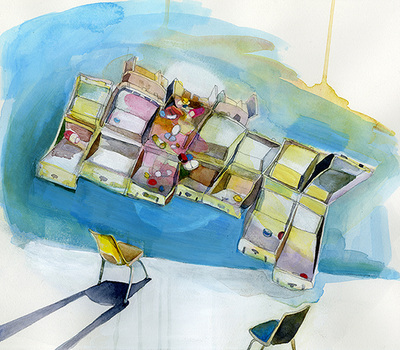
Jewel Box (2015)
Yet perhaps this reading does not say enough about the transformative power of space–more accurately, Morrow’s work represents a case of small-scale psychological and physical exile, on Edward Said’s terms. Originally from Kansas (arguably already physically removed from the contemporary art scene), Morrow developed these latest works over a one-week residency in physical exile in New York City. When Said writes in Reflections on Exile that “[a]ll nationalisms in their early stages develop from a condition of estrangement,” I am reminded of Morrow’s description of her relationship to her husband and home, in which she felt that she no longer existed as herself given a simultaneous estrangement from and need to care for her husband. The loyalty to that home, to her husband, perhaps developed from a feeling that she had lost her connection to the people and place denoting “home.” She left by choice to complete the residency, knowing that she would be able to return, and the resulting transformation in her work parallels the transformations Said notes in his essay.
Once in physical exile, as Said suggests, Morrow turned to “investigations of self that inevitably go far beyond such simple and positive facts as ‘ethnicity,'” or what in Morrow’s case may be translated as “contemporary artist.” The residency for Morrow provided a vantage point from which to better investigate her identity, “a scrupulous subjectivity” as it is constituted by conflicting roles. Adorno concluded that the only home is in writing, but Morrow seems to conclude that home is in art instead.
Artists don’t operate in a vacuum, and when a maelstrom pulls them in or exile shuts them out, they must leave the current for a while until they can find a way to return or pull themselves out. As a space for psychological retreat and development, the blank page–or white space, or exile–facilitates struggle, redefinition, and emergence. Once the artist returns to the current, she is changed. The current welcomes her back.
All images courtesy of the artist

